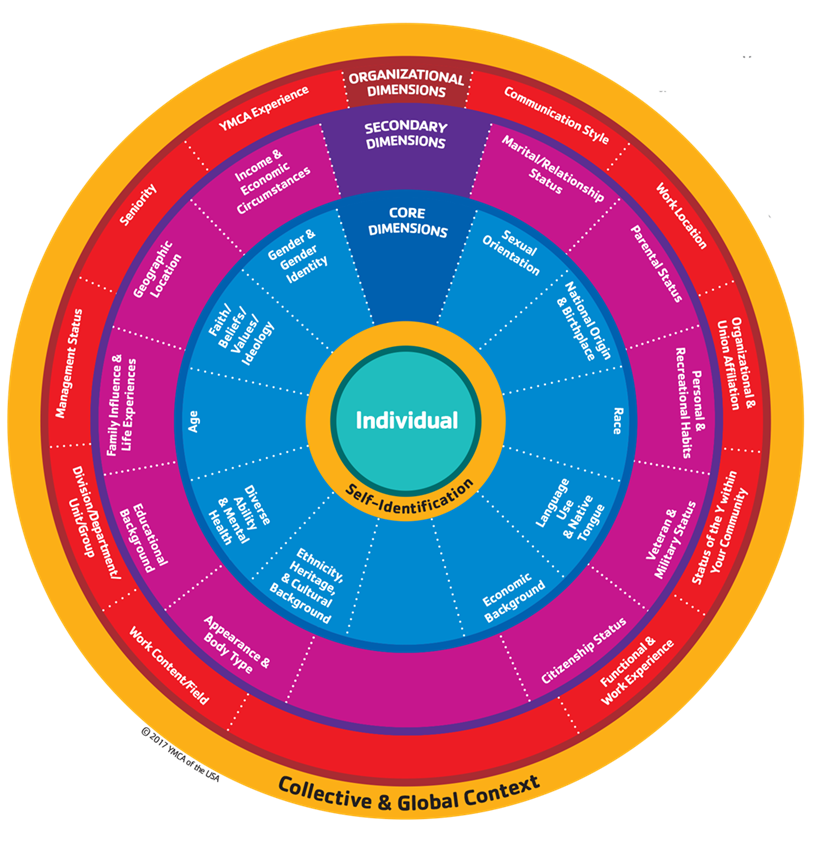OUR COMMITMENT TO DIVERSITY, EQUITY & INCLUSION
The YMCA of MEWSA's mission of diversity, equity and inclusion is to strengthen our community by respecting and valuing differences that include ability, age, cultural background, ethnicity, faith, gender, gender identity, ideology, income, national origin, race or sexual orientation. Our mission is to provide everyone with an equal opportunity to reach their full potential with dignity.
We aim to do this FOR ALL by utilizing our core values of caring, honesty, respect and responsibility. We recognize that a diverse and inclusive organization is foundational to developing and engaging everyone across the entire Y spectrum, both internally and externally. Our volunteers, members, program participants, families, leaders, staff, vendors, suppliers, donors, collaborators, and the community at large all contribute to our efforts to make positive, lasting personal and social change.
WHAT IS DIVERSITY, EQUITY & INCLUSION?
Diversity:
The presence of differences that make each person unique and that can be used to differentiate groups and people from one another.
Equity:
Equity is the guarantee of fair treatment, access, opportunity, and advancement for all, while striving to identify and eliminate barriers that have prevented full participation of some groups; it acknowledges historically underserved and underrepresented populations, and that fairness regarding these unbalanced conditions is needed to assist equality in the provision of effective opportunities to all groups.
Inclusion:
The full engagement and development of all Y stakeholders (staff, participants, members, policy volunteers, program volunteers, partners, communities, vendors, etc.).
DIVERSITY, EQUITY & INCLUSION (DEI) COMMITTEE
The Diversity, Equity & Inclusion (DEI) Committee of the YMCA of Metuchen, Edison, Woodbridge & South Amboy is made up of members from our Association Board and Branch Boards as well as key staff that hold different positions at each one of our branches. The committee meets monthly to discuss the organization's diversity and inclusion priorities to ensure all segments of society have access to the Y. The following are questions that drive the work of the committee:
- How do we respond to changing community demographics?
- How do we engage diverse population and ensure access to the Y?
- How do we strengthen our diversity and inclusion practices?
- How do we adapt policies and procedures to ensure relevancy to diverse populations?
THE MANY DIMENSIONS OF DIVERSITY

The Y is made up of people from all walks of life who are joined together by a shared commitment to ensure that everyone has the opportunity to learn, grow and thrive.
This Diversity Wheel diagram represents the various dimensions of diversity. To truly be inclusive and welcoming to all, it is critical to understand the many factors that make up and influence a person’s individuality. If we hold too narrow a view of what constitutes diversity, we will miss opportunities to effectively engage, connect and serve ALL members of our communities.
INDIVIDUAL
At the very center of the Wheel is the individual. All dimensions of diversity connect back to our unique experiences and perceptions of the world around us. Therefore, we are indivisible from them.
SELF-IDENTIFICATION
Self-identification stresses the importance of how we see ourselves in determining our dimensions of diversity.
CORE DIMENSIONS
Core dimensions are central to our personal experience, have sustained influence in our lives, and are often the dimensions that we most closely identify with. Many of these dimensions are unchangeable – reflecting how we were born – though some may change over the course of our lives. The core dimensions include: • Age • Diverse Ability & Mental Health • Economic Background • Ethnicity, Heritage & Cultural Background • Faith/Beliefs/Values/Ideology • Gender & Gender Identity • Language Use & Native Tongue • National Origin & Birthplace • Race • Sexual Orientation
SECONDARY DIMENSIONS
Secondary dimensions, while critically important in determining our identity, have a greater degree of control or self-determination to change, which is not as present in our core dimensions. The secondary dimensions include: • Appearance & Body Type • Citizenship Status • Educational Background • Family Influence & Life Experiences • Geographic Location • Income & Economic Circumstances • Marital/Relationship Status • Parental Status • Personal & Recreational Habits • Veteran & Military Status
ORGANIZATIONAL DIMENSIONS
These dimensions contribute to how we experience our time with the Y. They help to shape how we approach our work and how we connect with others across the Y Movement. The organizational dimensions include: • Communication Style • Division/Department/Unit/Group • Functional & Work Expertise • Management Status • Organizational & Union Affiliation • Seniority • Status of the Y within Your Community • Work Content/Field • Work Location • YMCA Experience
COLLECTIVE & GLOBAL CONTEXT
This ring highlights the role of the outside world in shaping how we define our dimensions of diversity. Just as self-identification emphasizes the importance of how we see ourselves, collective and global context emphasizes the importance of how the world perceives us.
BLANK SPACES
The blank spaces in the core, secondary and organizational dimensions acknowledge that the Diversity Wheel can never accurately (or fully) represent any single person’s experiences. These spaces allow an individual to add dimensions that are important to their identity. For more information, visit Link (link.ymca.net) or ca
Diversity, inclusion and equity is essential to helping Y's ensure that all segments of our communities are welcome and engaged. Please take a moment to fill out the feedback form to help us develop and adapt programs, services and program policies to ensure that all segments of society have access to the Y.